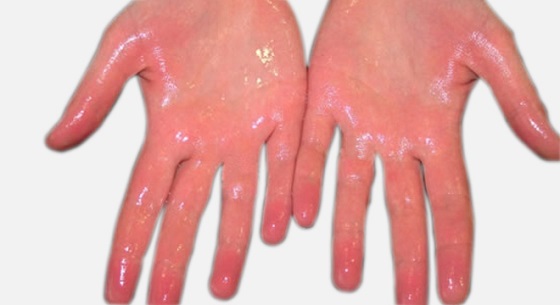How to Stop Sweaty Hands: Specialist Dermatology Recommendations for Handling Excessive Sweating
How to Stop Sweaty Hands: Specialist Dermatology Recommendations for Handling Excessive Sweating
Blog Article
Revealing the Complexities of Excessive Sweating: A Comprehensive Overview to Medical Diagnosis and Administration
Extreme sweating, clinically recognized as hyperhidrosis, is a problem that impacts a considerable number of people and can have a profound impact on their quality of life. While sweating is an all-natural physical feature, its overactivity in hyperhidrosis presents an unique set of challenges that often go beyond plain discomfort.

Understanding Hyperhidrosis Causes
Hyperhidrosis creates can be connected to different aspects such as genetics, hormonal discrepancies, and certain clinical problems. Genes play a significant duty in main focal hyperhidrosis, where individuals inherit the condition from their household participants. By identifying the particular elements contributing to extreme sweating, medical care carriers can customize therapy plans to attend to the underlying reason, offering relief and improving the quality of life for people impacted by hyperhidrosis.
Recognizing Hyperhidrosis Effects

In addition, hyperhidrosis signs may manifest in emotional and social distress, as individuals might feel ashamed or anxious concerning their sweating, causing avoidance of social scenarios (Treatment for hyperhydrosis of hands). Furthermore, repeated episodes of extreme sweating can result in skin maceration, fungal infections, and a general decrease in self-esteem
Diagnostic Process for Hyperhidrosis
Initiating the diagnostic procedure for extreme sweating includes thorough analysis of the individual's clinical background and physical assessment. Making inquiries about the onset, duration, and sets off of sweating episodes is critical to set apart between primary focal hyperhidrosis and secondary generalized hyperhidrosis. Case history must also include concerns about medicines, clinical conditions, and household background of hyperhidrosis.
During the physical exam, specific interest is paid to the locations affected by sweating. The health care provider might assess the level of sweating, look for signs of underlying conditions, and assess the effect of sweating on the individual's lifestyle. Furthermore, specific tests like the gravimetric test, starch-iodine test, or skin conductance measurements might be conducted to quantify the amount of sweat generated.
Additionally, in situations where secondary hyperhidrosis is presumed, added tests such as blood tests, pee tests, and imaging research studies might be suggested to determine the underlying root cause of excessive sweating. The diagnostic process aims to precisely identify the type and cause of hyperhidrosis to guide suitable administration techniques.
Treatment Options for Hyperhidrosis
When dealing with excessive sweating, numerous therapy alternatives are offered to minimize symptoms and improve the individual's top quality of life. The treatment technique for hyperhidrosis depends upon the severity of symptoms and the individual's action to preliminary therapies.
Topical treatments, such as aluminum-based antiperspirants, are frequently advised as the first line of protection for managing light instances of hyperhidrosis. For individuals with a lot more severe signs, dental medications like anticholinergics might be prescribed to aid decrease sweating.

Effective Administration Approaches
To successfully take care of hyperhidrosis, a thorough and customized treatment plan tailored to the individual's particular needs and response to previous therapies is essential. This strategy might include a combination of therapeutic approaches, consisting of way of living adjustments, topical therapies, oral medications, botulinum toxin shots, iontophoresis, and in serious cases, medical treatments like sweat gland removal or sympathectomy. Way of living alterations such as using moisture-wicking clothing, making use of antiperspirants, and exercising stress-reducing techniques can complement clinical interventions. Topical antiperspirants containing light weight aluminum chloride are commonly the first-line treatment, with more powerful solutions available for immune instances. Oral drugs like anticholinergics may be prescribed for generalized hyperhidrosis. Botulinum contaminant injections are effective for focal hyperhidrosis, supplying short-term alleviation by blocking the release of acetylcholine. Iontophoresis, entailing making use of a reduced electrical existing to decrease gland activity, can be Treatment for hyperhydrosis of hands and feet helpful for both palmoplantar and axillary hyperhidrosis. Surgical options are generally booked for severe, refractory cases and need cautious consideration of advantages and dangers. A multidisciplinary method involving dermatologists, main care physicians, and, if essential, specialists, can optimize the monitoring of hyperhidrosis.
Conclusion
In conclusion, hyperhidrosis is a condition identified by extreme sweating, which can considerably affect an individual's top quality of life. With appropriate diagnosis and management strategies, individuals experiencing from hyperhidrosis can locate alleviation and enhance their total wellness.
Excessive sweating, clinically understood as hyperhidrosis, is a problem that influences a significant number of individuals and can have a profound influence on their high quality of life. By determining the specific factors adding to excessive sweating, medical care providers can customize treatment strategies to attend to the underlying cause, using alleviation and boosting the quality of life for people affected by hyperhidrosis.
Hyperhidrosis, identified by extreme sweating past what is required for regulating body temperature, can substantially influence an individual's high quality of life. Making inquiries regarding the start, duration, and causes of sweating episodes is crucial to differentiate in between primary focal hyperhidrosis and additional generalised hyperhidrosis. Sweaty hands treatment.In verdict, hyperhidrosis is a condition identified by too much sweating, which can substantially impact a person's top quality of life
Report this page